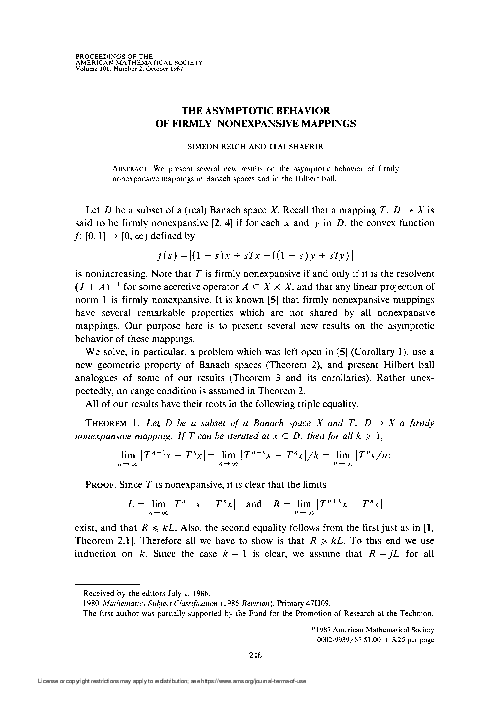Academia.edu no longer supports Internet Explorer.
To browse Academia.edu and the wider internet faster and more securely, please take a few seconds to upgrade your browser.
The asymptotic behavior of firmly nonexpansive mappings
The asymptotic behavior of firmly nonexpansive mappings
1987, Proceedings of the American Mathematical Society
Related Papers
Nonlinear Analysis: Theory, Methods & Applications
Asymptotic behavior for asymptotically nonexpansive mappings1996 •
Computers & Mathematics with Applications
Convergence theorems for nonself asymptotically nonexpansive mappings2008 •
Carpathian Journal of Mathematics
On α-nonexpansive mappings in Banach spacesIn 2011 Aoyama and Kohsaka introduced the α-nonexpansive mappings. Here we present a further study about them and their relationships with other classes of generalized nonexpansive mappings.
Thai Journal of Mathematics
Strong Convergence Theorem for Some Nonexpansive-Type Mappings in Certain Banach Spaces2020 •
Let E be a uniformly convex and uniformly smooth real Banach space with dual space E^*. A new class of relatively J-nonexpansive maps, T : E → E^* is introduced and studied. A strong convergence theorem for approximating a common J-fixed point of a countable family of relatively Jnonexpansive maps is proved. An example of a countable family of relatively J-nonexpansive maps with a non-empty common J-fixed point is constructed. Finally, a numerical example is presented to show that our algorithm is implementable.
International Journal of Nonlinear Analysis and Applications
Some properties of generalized fundamentally nonexpansive mappings in Banach spaces2021 •
In this paper, we introduce a condition on mappings and show that the class of these mappings is broader than both the class of mappings satisfying condition (C) and the class of fundamentally nonexpansive mappings, and it is incomparable with the class of quasi-nonexpansive mappings and the class of mappings satisfying condition (L). Furthermore, we present some convergence theorems and fixed point theorems for mappings satisfying the condition in the setting of Banach spaces. Finally, an example is given to support the usefulness of our results.
Research & Reviews Journal of Modern Physics: “G-D’S PHYSICS” NEW TWENTY-FIRST CENTURY SCIENTIFIC PARADIGM Special Issue :
When Will Science Finally Accept "G-D's Physics" As the New Twenty-First Century Physics Paradigm2024 •
Due to a major "Paradigmatic Crisis" of the Old "Material-Causal-Random" Paradigm of Twentieth Century General Relativity Theory (GRT) and Quantum Mechanics (QM) as signified by a fundamental "theoretical inconsistency" between its two primary "pillars", e.g., General Relativity Theory (GRT) & Quantum Mechanics (QM), and its principle inability to account for the "Hubble Tension's" increase in the universe's rate of expansion – from its initial (early-stage) Cosmological Measurements to the current Astronomical Measure value (e.g., assumed to be accounted for by purely hypothetical & undetected "Dark-Matter" [DM] comprising up to 95% of all the mass in the universe?!) In this (seminal) article The New "G-D's Physics" Scientific Paradigm" is being tested based on direct empirical validations of two of its unique "Critical Predictions": associated with a "Collective Human Consciousness Focus" postulate predicted "Non-Continuous Increase in the Universe's Expansion Rate" (UNCIARE) during the "Jewish Rosh-Hashana" (two days special time interval), and the "Proton Radius Puzzle" findings; Based on direct empirical evidence validating these two unique "G-D's Physics" Critical Predictions (e.g., more valid than corresponding predictions of both GRT & QM) "G-D's Physics" must be accepted as the New (valid) Twenty-First Century Physics Paradigm! An additional "G-D's Physics' Seven Months' Challenge (for Astronomers all of the world!) is called for: to further "G-d's Physics" precise UNCIARE-JRH's increase in the current Astronomical Measure of the universe's expansion rate (i.e., to be measured during the next seven months at an accuracy level of of 0.000968 km s −1 Mpc) by a "Minute Annual Increase" (MAI) of 0.000968 km s −1 Mpc: that will occur on the next JRH, on Oct. 3rd -4th, 2024 (and carry on until the next JRH: Sep. 22nd-23rd , 2025 – in which another MAI of 0.000968 km s −1 Mpc will be added to the universe's accelerated rate of expansion!) To the extent that this specific "G-D's Physics" UNCIARE-JRH MAI (of 0.000968 km s −1 Mpc) will be validated empirically then this will unequivocally validate "G-D's Physics" whole new theoretical model, alongside its emphasis of the centrality of the CHCF (JRH), and the actual Cosmological age of the universe! It would also further substantiate "G-D's Physics" postulated existence of a singular higher-ordered "Universal Computational/Consciousness Principle" (UCP) which simultaneously computes all exhaustive spatial pixels in the universe (at the "unfathomable" rate of "c2/h" = 1.36-50 sec'!) and which has "pre-planned" (and is continuously "executing"- and "adjusting") the development of the whole universe from "inanimate" matter through "animate": plants, animals and human-beings towards the "Ultimate Perfected Geulah State"; in which Science & Humanity will recognize the singularity of this UCP, alongside its "sublime" characteristics of "All-Goodness", "Morality", "Peace" & "Harmony" (e.g., bound to affect Humanity's existence and behavior – with Physics' Scientific Community's current inevitable acceptance of "G-D's Physics" New Twenty-First Century Scientific Paradigm)!
Jurnal Akuntansi - Fakultas Ekonomi Universitas Tarumanagara
Taxpayer Compliance Determinants: An Empirical Study2019 •
International Journal of Innovative Research and Reviews
Overview of Methods of Collection and Processing of Geographic Data2021 •
RELATED PAPERS
Stem Cell Reviews and Reports
Therapeutic Potential of Secreted Molecules Derived from Human Amniotic Fluid Mesenchymal Stem/Stroma Cells in a Mice Model of Colitis2016 •
2016 •
Atmospheric Pollution Research
Assessment of WRF/Chem PM2.5 forecasts using mobile and fixed location data from the Fairbanks, Alaska winter 2008/09 field campaign2012 •
2016 •
arXiv (Cornell University)
JWST CEERS probes the role of stellar mass and morphology in obscuring galaxies2023 •
„Wykrzesać pokrewieństwo burzy”. Drogi Jana Kasprowicza do wielkości. Szkice i studia, red. R. Okulicz-Kozaryn, K. Jaworski, M. Jauksz, Wydawnictwo Naukowe UAM, Poznań 2021, s. 159–167.
Od-budowane w poezji. Średniowieczne kościoły Jana Kasprowicza2021 •
Technology audit and production reserves
Development of force and communication management methodology using resource optimization methods in military (force) operations2022 •

 Itai Shafrir
Itai Shafrir